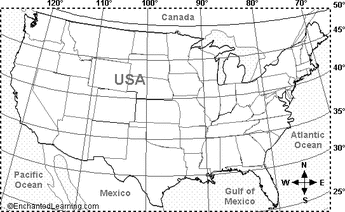 Vernalization Many hop growers are asking this question as the abnormally mild weather persists across much of the USA. For most growers in northern latitudes; probably not much effect will be noted. Average hop vernalization temperature requirements of 6 weeks below 38 degrees Fahrenheit will still be met, resulting in normal burr and cone development later in the season. Expect an earlier emergence of pests and disease that the milder winter failed to kill. For growers in more southern latitudes the story could be completely different. Effects on the hops in the southern tier could include: lack of proper vernalization, increased pest pressure, and increased prevalence and severity of hop diseases like downy and powdery mildews. Hop vernalization requirements vary by hop genotype and varieties that require longer chilling periods may not properly reset back to the juvenile spring phase required to grow and produce a normal yield of cones. One of the first signs of incomplete vernalization is uneven spring emergence of new shoots within plants of the same hop variety. Growers in the PNW have noted that this uneven emergence follows through the entire growing season; affecting cone-set, yield, alphas, and maturity dates. The cone-bearing sidearms may not extend properly and only produce cones on the terminal ends. Many affected hop plants showed up to a 6 week delay of burr initiation and a 30 to 50% loss in total potential yield. It's All About Balance Fertile soil is a mixture of well-balanced minerals, high organic matter, humus, humic, fulvic and carbonic acids, good aeration and bountiful microbial life. The biology or life in the soil is at its healthiest when the nutrients are plentiful and balanced, and there is sufficient oxygen and water. The top soil region is the most vital portion of the soil profile; holding about 70% of the life and 70% of the organic matter. In a typical soil, below 6 inches plant roots are feeding on mostly soluble nutrients since the micro-organisms are not able to thrive due to insufficient oxygen levels. Many minerals are tightly bound to the subsoil colloidal particles are only made available to plants through complex soil interactions with organic acids leaching downward from the topsoil. It is critical to maintain the organic matter content in soils for them to remain balanced and healthy. Download as PDF No doubt about it, for many new growers hops are a difficult crop to grow well. Fast growing hop plants require lots of balanced nutrients and water with critical timing of applications; making hops a real challenge to keep up with when compared to most other crops. Getting the hops to climb to the top trellis wire and produce fully developed side arms with lots of cones seems to be an unattainable goal sometimes. There always seems to be a guy named Murphy lurking around, ready to throw a wrench in the works; despite a hop grower’s best efforts. Wind, rain, drought, and pestilence... yet there are lots of pretty pictures of hopyards and recorded harvest yields to show it is more than a dream. It is common to find in many instances, less experienced hop growers do not fully understand many integrated hopyard management practices and how plant nutrient availability and growth is affected. This following discussion covers a few of the issues that have been identified as potentially holding back hop growth and yields. These issues are gleaned from talking to, and working with hundreds of new hop growers and the challenges they have experienced. These observations and field notes are intended to educate and provoke deeper, more in-depth discussions amongst hop growers and grower groups.
Downy mildew (DM) of hops is a major disease that affects many susceptible cultivars of hops. It can severely damage both the hop plant as well as making the cones unsuitable for harvest. This discussion pertains to using post harvest DM controls to help hopyards recover from a season of high downy mildew infection. Many hop growers do not understand the importance of controlling downy mildew in their hop yard after harvest is completed. The fungus and the infection are not as visible as springtime symptoms. Many growers consider the season as finished at harvest and leave the yard unattended going into winter. This is a fundamental mistake in controlling DM in infected hopyards. Downy mildew is active whenever conditions permit – it simply doesn't care if it is springtime, summer, or fall. If green plant tissue, moisture and the right temperatures are present, DM will remain active. Post-harvest fungicide applications and controls can be an effective way to manage downy mildew in yards that have had the disease present and reduce the severity of downy mildew spikes that emerge during the following spring growing season. 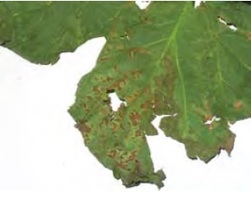 leaf lesions caused by downy mildew. (D. H. Gent) leaf lesions caused by downy mildew. (D. H. Gent) Downy mildew, like most molds and mildews, persists and spreads during the growing season mainly through air-borne spores which infect new leaves and growth whenever environmental conditions are favorable. In the Fall season, however, downy mildew “morphs” into a different creature; producing a specialized motile spore type called a zoospore. This spore acts much more like a living microscopic worm than a fungal spore. The motile zoospore form helps downy mildew complete its annual life cycle by finding a safe resting place for it to overwinter or by forming protective dormant oospores. These forms of DM exist outside of the plant in the soil where it is outside its host and can be interrupted at this point. 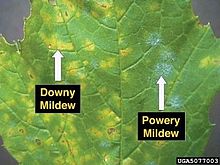 This grower blog deals only with the post-harvest practices in traditional commercial hopyards and some best practice strategies to control and reduce the percentage of overwintering DM and other pathogens. Great Lakes Hops uses these combined practices and has found them to be very effective in the Midwest region hop production. Control of downy mildew (DM) in the hopyard is an ongoing challenge for growers in many regions; and especially difficult for growers that have susceptible hop varieties. DM takes different forms and produces several different spore types in reaction to environmental conditions - i.e. aerial, oospores, and zoospores. Each spore type has its own set of specific control measures. DM is active whenever temperature and moisture conditions are correct; spring, summer, and fall. In the fall season, downy mildew switches from actively producing airborne spores that mainly affect the bines, foliage, and cones; to forming protective oospores and motile zoospores that can overwinter in the soil and dormant hop crown. The more familiar springtime DM spikes on new shoots are less evident in the fall as hop growth slows and the infected older foliage takes on a mottled appearance; which many growers fail to notice. Once DM has a foothold in a hopyard, outside airborne spores are not necessary to re-start early springtime infections. Great Lakes Hops has found the following fall practices to be effective in gaining good control over downy mildew and other pests and pathogens in hopyards. 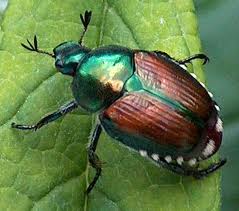 Japanese beetles are proving to be a formidable foe in hop yards located in the Great Lakes region. The beetles can cause significant damage to hop foliage and bines in a very short period of time if left uncontrolled. Two beetles can strip a large hop leaf in a single day and when their numbers reach the thousands, the beetles can strip a hop yard in just a few days. Organic hop growers find controlling them especially frustrating because they cannot apply the synthetic chemical controls commonly utilized. Here are some control strategy tips for all hop growers – organic and non-organic. First concept: Beetles attract more beetles. I do not consider Japanese beetles to be a threshold control-type pest where the decision to spray is based on tolerating a certain level of pests before treatment or spraying is done. Female beetles excrete pheromones to attract males and mating is a gregarious affair – a “beetle orgy” for lack of a better term. Beetles fly into the wind and follow the beetle pheromone trail to the plants and leaves where feeding and mating occur. Females apparently leave pheromones on the leaves; as I note that beetles arrive and continue to congregate on the same leaves – even if the original beetles are removed. However, a good hard rainfall seems to wash away this residual pheromone trail. It is well known that hanging pheromone traps can attract large number of both male and female beetle from great distances. A population of mating beetles will grow exponentially as congregating beetles emit stronger pheromone trails for newcomers to follow to the orgy – just like a pheromone trap. Allowing the beetles to establish a population in a hop yard is exactly like hanging pheromone traps in the middle of your hop yard. 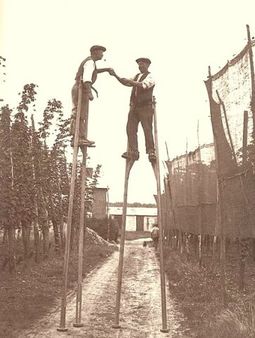 Creating the optimal hop yard that produces maximum yields with minimal infrastructure, labor, and inputs is critical to long term success & profitability of a hop yard. Hopefully the following discussion can help improve understanding of how to achieve the optimally yielding hop yard for those just starting. Choosing the right Trellis design begins with and ends with an understanding of the hop plant itself. It is very important to understand how hops grow, what makes them produce optimal yields, and what the differences are between varieties and genotypes. Some thoughts to immediately discard:
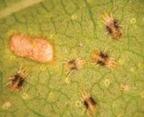 The Two Spotted Spider Mite in the Northeast Hopyard www.uvm.edu The two spotted spider mite (TSSM) Tetranychus urticae Koch is a common pest of many crops and ornamentals. Hop growers, landscapers, arborists, and vegetable and fruit growers are familiar with these small 8 -legged creatures that are more closely related to spiders than insects. They can be a major cause of ... Grower Notes: Low levels of spidermites are being reported by several growers. So far the cool wet weather has kept them in check - watch out if the weather goes hot & dry!
Also, powdery mildew has been seen on weeds around the hop yards; so conditions are right for it to form - scout the lower leaves for visual symptoms. Many varieties of hops are entering the burr stage and burrs infect easily during wet humid weather. An effective protectant fungicide for burr stage is Quintec. Apply it as a preventative if the wet weather continues during cone formation and you have seen foliar symptoms. The crop in Northern Michigan appears to be running about two weeks behind the Southern Michigan hop yards - so adjust accordingly. I am busy doing field checks with hop growers during the month of May. I am finding winter crown desiccation in new hop yards that did not have reliable snow cover. The crowns appear to have been exposed to sun & wind while the ground was frozen. The fleshy roots remain white - no rot is present. The frozen soil/roots could not supply water to the exposed crown as it is dried out by the sun & wind. There have been no reports of this type of winter damage from up North, where they had good snow cover. Varieties like Zeus, Glacier, Saazer, Nugget & Cascade were affected more than varieties like Chinook. Protecting these crown buds from exposure is important ! Some of these damaged crowns may regenerate slowly; given time. Our winter exposures and duration are longer and harsher in the Midwest than those out in Oregon and Washington. 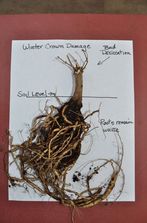 Click to enlarge Click to enlarge Crown buds can be protected in several ways as you prepare you hop yard for winter. First, leave the hop bines cut at 24 to 36 inches high over the winter. The old bines supply extra sugars to the crowns and act like little snow fences; slowing the wind, holding snow and field debris around the crowns. Second, physically cover the young crowns - protective mulches or field soil 1 to two inches deep is a typical field practice. Third, apply a high potassium fertilizer in the fall to winterize the hop plants. Hop yards with low potassium levels experience higher levels of winter crown bud damage. A close placement of granular or dissolved through the drip system is necessary for it to be effective; since the fine feeder root mat formed during the growing season is breaking down and disappearing. The potassium ion prevents ice crystals from forming in the plant tissues and allows water movement at lower temperature ranges. (Think of potassium as anti-freeze for your hops!) 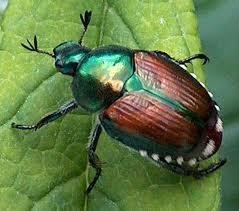 Experienced hop growers will be the first to tell you that a regular weekly schedule of checking your hopyard for problems can save big headaches, time, and cold hard cash. Being a good grower isn't about who has the biggest pesticide budget! Catching problems like pest and fungal outbreaks early is critical to controlling them successfully; with minimal treatments - before the damage is done. Proper scouting includes a close examination of the entire hopyard's environment (including the surrounding fenceline perimeter's). (This pest is capable of defoliating entire plants in less than a week) For quick knockdown of a Japanese beetle /Potato leafhopper outbreak for growers with RUP certification - check out Brigade 2ec or Leverage 360/2.7. Both are labelled for hops. TO DO LIST
If this sounds like too much work; please do consider hiring a professional crop scout. They know what to look for and when to look for it. Their services are relatively inexpensive and their advice - priceless. Properly done scouting and recording what you see in detail lets you identify patterns and conditions that affect the hop's growth and what conditions trigger disease and pest outbreaks. I recommend making a check-off form you use weekly during the growing season that covers all the above items so you don't miss anything. This will not only make you a better grower- it will make you a PROACTIVE grower. (I like to call them Jedi-growers because they always seem to know what is going to happen before it does.) Proactive growers can make minimal, targeted sprays; anticipating disease and pest cycles. They consistantly adjust - fertilizer, irrigation schedules, cultivation; like a steady clock. They also always seem relatively cheerful and un-stressed. (nice side-effect that both wives and partners seem to appreciate!) Scouting is something I do habitually 24/7 - I'm looking when I'm watering - I'm looking when I'm weeding- Heck, I'm looking when I walk the dog! |
Details
Blog AuthorLynn, the head hop grower at Great Lakes Hops has over 30 years of experience in the horticultural field. Browse the blog articles here to find useful growing information for humulus lupulus, based on personal experience and observations at Great Lakes Hops. Archives
January 2020
Categories
All
|
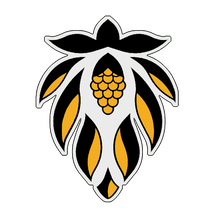

 RSS Feed
RSS Feed